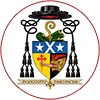HOMILY FOR MIDNIGHT MASS 2015
The New Testament begins with St Matthew telling us the story of Jesus’ birth. He begins, after the list of Jesus’s ancestors, with Joseph. He shows us a troubled man: troubled because he is a good man, a just man, who wants to do what is right. This cannot, he thinks, be to take Mary as his wife when she is having a child that is not his. At the same time he wants to be loving and loyal to Mary.
God provides an answer for Joseph. Then Matthew moves quickly, with the Magi, to another troubled man: King Herod. Not only the King, but all Jerusalem with him is troubled by the Magis’ question, ‘Where is the newborn King of the Jews, whose star we saw rising in the East?’ Joseph’s troubles affect nobody outside his household. The troubles of the King upset the whole centre of government. Herod does not need God to provide an answer. The King easily finds his own solution to his troubles, as powerful men do. He unleashes a wave of violence against anybody who might possibly threaten his power. The children die, and the Holy Family become refugees.
It is a very familiar pattern. There are many Josephs today, many simple people only trying to do what is right and loving, and they and their families are caught up and swept away by the solutions that the rulers of this world come up. There are many refugees.
Matthew portrays to us the world of his day, into which the Saviour comes. It is a world just like ours. It is our world.
Tonight, we don’t listen to Matthew. We listen to another narrative of the birth of Jesus, Luke’s. And in this narrative, we hear nothing of the great political events of the day, of Herod and his troubles, of the unstable social and political situation into which Jesus is born. There is great poverty: Jesus is born in stable and placed in a manger. But his birth is in peace and serenity.
By contrast with Herod and his soldiers seeking to murder the child, Luke shows us a child surrounded by people who love and protect him. It follows the pattern set in his portrayal of the birth of the forerunner of Jesus, John the Baptist. The news of John’s of John’s birth is greeted with joy and wonder as it spreads through the hill country of Judea. Jesus’ birth is sung by angels and he is worshipped by the shepherds. There is no hint of the shadow cast by Herod.
It can happen in this world, and let us pray that it will happen for child refugees of today, that loving families and neighbours, in the midst of upheaval, create for their children a different narrative than that which he powers of the world try to impose. They tell their children a story of love and peace, and create around them an atmosphere of happiness. Certainly, this is what Joseph and Mary do for Jesus.
But there is more. Luke’s narrative of Jesus’ birth is not a fairy tale for children. It is God’s narrative of the true history of the world. It is the continuation of prophecy. What Luke is giving us is the scriptural portrayal of the messianic age. Our faith is the acceptance of this narrative, and its continuance into our time.
Faith does not exempt us from suffering. Luke is fully aware of the realities portrayed so vividly by Matthew. In both Matthew and Luke, the shadow of the Cross is over the birth of Jesus. In Matthew, we see it in its stark physical reality. In Luke, it is introduced gently and loving by the words of the last ancient prophet, Simeon. Simeon prophecies that a sword that will pierce the heart of Mary, the heart of the believer. The last word in our story does not belong to the power of this world represented by the sword of Herod. The last word is God’s. His word, like a sword, pierces the human heart, not for destruction, but to open up the depths of our being to the new life that comes so gently into our world with the birth of Jesus.
